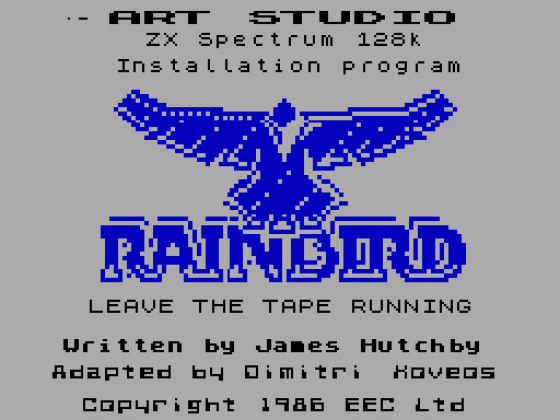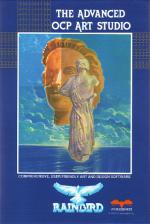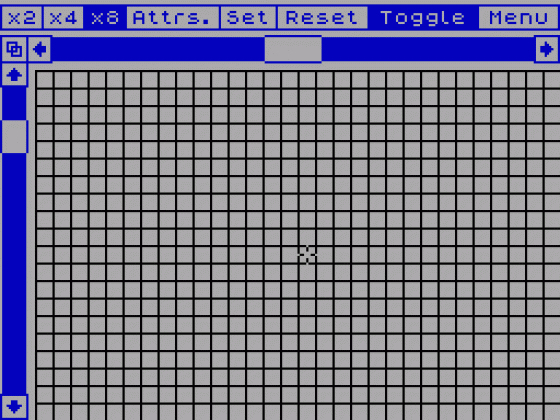
Crash
 1st May 1987
1st May 1987
Categories: Review: Software
Author: Franco Frey
Publisher: Rainbird
Machine: Spectrum 128K
Published in Crash #40
Advanced Art Studio
OUR RESIDENT ARTECHNIST FRANCO FREY, TAKES PALLETTE AND MOUSE IN HAND TO ASSESS THE POTENTIAL FOR THIS UPDATE UTILITY WHICH WILL COST YOU £24.95.
Back in 1985 OXFORD COMPUTER PUBLICATIONS LTD brought the flair of Macintosh into the Spectrum world by releasing ArtStudio. Nobody really thought it possible to create an icon- and mouse-driven drawing utility sprouting pull down menus all over the screen, and yet programmer James Hutchby did just that, and brought the new working technique to the Spectrum.
Sadly, the program's success didn't save the terminally ill OCP, and Artstudio and its derivatives is marketed by RAINBIRD. They're doing a good job of too, and are now releasing an advanced version incongruously called The Advanced OCR Art Studio (TAOAS for short). Contrary to belief, this does not require a major house extension to accommodate it, but to savour all the advanced features, it is necessary to own an Interface One and Microdrive (cassette-based owners still get some benefits).

The original ArtStudio was reviewed donkeys years ago, but to refresh readers' memories, the Features Table should be indicative of the original's power.
Cramming more features into the advanced version didn't entail squeezing more memory out of the 48K but the asking of Spectrum owners to upgrade to the 128 machine. This can be either the old Sinclair black 128K or the new Alan Sugar grey Spectrum 128 +2. Having bought an extension lead to connect the Interface One to the Plus Two (talking of a tight squeeze...), the loading instructions read like a Tolstoi novel, and the sooner the program is transferred onto Microdrive the better.
All the facilities of ArtStudio are available on the advanced version with the addition of the ZX Microdrive controls, filing facilities for user-defined Fill Patterns and Paint Brushes, Ramdisk and Scrapbook plus an extra 'arc' shape in the SHAPES menu.
THE RAMDISK TAOAS uses part of the computer's extra memory as Ramdisk, which behaves just like a normal random access mass storage device. Files are saved in it by name and can be catalogued. loaded, saved, merged and erased in a fraction of the time compared to Microdrives. Its only problem is its volatility. Should the power be switched off, don't blame anyone but yourself. So for storage you have the choice of Ramdisk and cassette, or Ramdisk and a maximum of four Microdrives. The Ramdisk facility is available via the filing options of FILE, PAINT, FONT EDITOR and SCRAPBOOK by selecting the M-drive option.
FILING TAOAS maintains a RAM-based catalogue of files that can be displayed and accessed without the need to read the cartridge each time. Selecting one of the above mentioned filing options, displays a storage command pulldown menu. Selecting the storage device (R,1,2,3,4) and Catalogue Cartridge, displays the available files. The required file can be highlighted and saved, loaded, merged (with the memory contents) or erased by selecting the correct function box.
Up to 49 entries can be accommodated in the RAM catalogue. New files can be created by the ENTER FILENAME option. All files are verified after saving. Apart from the screen files TAOAS can handle files for User-created Textured Fill Patterns. This is accessed from the FILL menu. Pattem files are automatically saved with a .pat extension, although this can be overridden (these files however will not be displayed in the Fill RAM catalogue).
Similarly TAOAS caters for user-designed brushes under the PAINT menu. All files here receive a .bas extension unless overridden. This leaves the user-designed Text Fonts, which are accessed in the FONT EDITOR menu. Default extension here is .Int.
SCRAPBOOK TAOAS provides a facility to create a library of designs which can be saved to tape, Microdrive or Ramdisk for future use. Parts of pictures, logos or special symbols can be lifted from the main screen and stored in the Scrapbook to be later pasted onto any working screen. Up to 16K of material can be stored. Access to Scrapbook is through the MISC menu.
The file option enables loading and saving of Scrapbooks to and from the Microdrives or Ramdisk. The report box on the right-hand side of the screen displays the Scrapbook statistics (number of items, free memory and used memory). Scrolling through the Scrapbook is achieved by clicking the up and down arrow boxes, and enables selection of the correct design. In order to be able to lift a detail from the main screen it's necessary to define a window in the WINDOW menu before selecting the INSERT option. For paste-up it may be necessary to select one of four perimeter boxes, which provides access to any part of the main screen edges when dumping Scrapbook designs on the main screen. Delete can be accomplished on a single design or on the whole Scrapbook.
SHAPES The ARC function has been added to the SHAPES menu. This is a fractional part of a circle. The first two points define the extremities of the arc, and the third point defines the curvature, although the arc does not necessarily link up to the third pant for some obscure reason
CONCLUSION The Advanced OCP Art Studio is a positive extension to Artstudio. Ramdisk goes a long way to providing a disk-like environment to the Spectrum 128K and increases the working speed enormously. The addition of a Scrapbook enables designs to be transported without much fuss from one screen to another and makes this user-friendly package user-loving. Dimitri Koveos is responsible for the 128K extensions and has done a worthwhile addition to Mark Hutchby's original program. It makes a desirable program even more desirable...
Other Reviews Of Advanced Art Studio For The Spectrum 128K
OCP Advanced Art Studio (Rainbird)
A review












